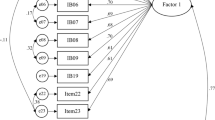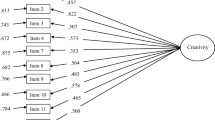Abstract
The 50-item Kaufman Domains of Creativity Scale (K-DOCS; Kaufman Psychology of Aesthetics, Creativity and the Arts, 6(4), 298-308, 2012) is a relatively new domain-specific self-report scale designed to assess the five different domains of creativity. However, a shorter form of the scale is preferable to reduce participants’ burden. The present research addresses the development of a shorter 20-item K-DOCS (20-K-DOCS) to be used on Malaysian undergraduates across three studies (N = 1409). On the basis of past findings, the four items with the highest factor loading for each of the five domains were extracted to construct the 20-K-DOCS in Study 1. Exploratory factor analysis on the 20 items showed support to the theoretical five-factor structure. In Study 2, confirmatory factor analysis was conducted to examine and compare the 20-K-DOCS with the parent form of K-DOCS and other competing models. Results indicated that the 20-K-DOCS were superior to all the alternative models. In Study 3, the factorial structure of the 20-K-DOCS was further examined. The five-factor model was supported. Moreover, the 20-K-DOCS showed good internal consistency and acceptable convergence with creative self-efficacy and self-rated creativity. The findings of this study strengthen the evidence that the 20-K-DOCS is a psychometrically equivalent short form of the original K-DOCS. Researchers and educators may consider this brief measurement to assess the five different domains of students’ creativity.
Similar content being viewed by others
Notes
Parallel analysis on the 20 items suggested four factors. Fixing the number of factor to four, however, resulted in the integration of the everyday and scholarly creativity. Moreover, items loaded on the integrated factor were found to have a factor loading lower than the suggested cutoff (.40). In total four items (of the scholarly creativity) were removed. Since the four-factor model was not theoretically compatible, we use the eigenvalue method.
References
Baer, J. (2012). Domain specificity and the limits of creativity theory. Journal of Creative Behavior, 46, 16–29. https://doi.org/10.1002/jocb.002.
Baer, J. (2016). Domain specificity of creativity. San Diego: Elsevier/Academic Press.
Barrett, J. D., Vessey, W. B., Griffith, J. A., Mracek, D., & Mumford, M. D. (2014). Predicting scientific creativity: The role of adversity, collaborations, and work strategies. Creativity Research Journal, 26, 39–52. https://doi.org/10.1080/10400419.2014.873660.
Beghetto, R. A. (2006). Creative self-efficacy: Correlates in middle and secondary students. Creativity Research Journal, 18(4), 447–457. https://doi.org/10.1207/s15326934crj1804_4.
Carson, S. H., Peterson, J. B., & Higgins, D. M. (2005). Reliability, validity, and factor structure of the creative achievement questionnaire. Creativity Research Journal, 17, 37–50. https://doi.org/10.1207/s15326934crj1701_4.
Cheung, G. W., & Rensvold, R. B. (2002). Evaluating goodness-of-fit indexes for testing measurement invariance. Structural Equation Modeling, 9(2), 233–255.
Corazza, G. E. (2016). Potential originality and effectiveness: The dynamic definition of creativity. Creativity Research Journal, 28(3), 258–267. https://doi.org/10.1080/10400419.2016.1195627.
Department of Statistics Malaysia (2017). Bab 4-Pendidikan 2017 [Data file]. Retrieved from https://newss.statistics.gov.my/newss-portalx/ep/epFreeDownloadContentSearch.seam?contentId=58391&actionMethod=ep%2FepFreeDownloadContentSearch.xhtml%3AcontentAction.doDisplayContent&cid=86529.
Franke, G. R., Rapp, A., & Andzulis, J. M. (2013). Using shortened scales in sales research: Risks, benefits, and strategies. Journal of Personal Selling & Sales Management, 33(3), 319–328. https://doi.org/10.2753/PSS0885-3134330306.
Grosul, M., & Feist, G. J. (2014). The creative person in science. Psychology of Aesthetics, Creativity, and the Arts, 8, 30–43. https://doi.org/10.1037/a0034828.
Hu, L. T., & Bentler, P. M. (1999). Cutoff criteria for fit indexes in covariance structure analysis: Conventional criteria versus new alternatives. Structural Equation Modeling: A Multidisciplinary Journal, 6(1), 1–55.
Hu, W., Wu, B., Jia, X., Yi, X., Duan, C., Meyer, W., & Kaufman, J. C. (2013). Increasing students’ scientific creativity: The “learn to think” intervention program. Journal of Creative Behavior, 47, 3–21. https://doi.org/10.1002/jocb.20.
Ivcevic, Z. (2007). Artistic and everyday creativity: An act-frequency approach. Journal of Creative Behavior, 41(4), 271–290. https://doi.org/10.1002/j.2162-6057.2007.tb01074.x.
Ivcevic, Z., & Mayer, J. D. (2009). Mapping dimensions of creativity in the life-space. Creativity Research Journal, 21, 152–165. https://doi.org/10.1080/10400410902855259.
Kaufman, J. C. (2006). Self-reported differences in creativity by ethnicity and gender. Applied Cognitive Psychology, 20, 1065–1082. https://doi.org/10.1002/acp.1255.
Kaufman, J. C. (2012). Counting the muses: Development of the Kaufman domains of creativity scale (K-DOCS). Psychology of Aesthetics, Creativity and the Arts, 6(4), 298–308. https://doi.org/10.1037/a0029751.
Kaufman, J. C., & Baer, J. (2004). Sure, I’m creative—But not in mathematics! Self-reported creativity in diverse domains. Empirical Studies of the Arts, 22(2), 143–155. https://doi.org/10.2190/26hq-vhe8-gtln-bjjm.
Kaufman, J. C., & Beghetto, R. A. (2009). Beyond big and little: The four c model of creativity. Review of General Psychology, 13(1), 1–12. https://doi.org/10.1037/a0013688.
Kaufman, J. C., Cole, J. C., & Baer, J. (2009). The construct of creativity: A structural model for self-reported creativity ratings. Journal of Creative Behavior, 43(2), 119–134. https://doi.org/10.1002/j.2162-6057.2009.tb01310.x.
Kaufman, J. C., Waterstreet, M. A., Ailabouni, H. S., Whitcomb, H. J., Roe, A. K., & Riggs, M. (2010). Personality and self-perceptions of creativity across domains. Imagination, Cognition and Personality, 29, 193–209. https://doi.org/10.1002/jocb.33.
King, R., Neilsen, P., & White, E. (2013). Creative writing in recovery from severe mental illness. International Journal of Mental Health Nursing, 22(5), 444–452.
Leung, A. K. -y., & Chiu, C. -y. (2010). Multicultural experience, idea receptiveness and creativity. Journal of Cross-Cultural Psychology, 41(5–6), 723–741. https://doi.org/10.1177/0022022110361707.
Lubart, T. I., & Sternberg, R. J. (1995). An investment approach to creativity: Theory and data. In S. M. Smith, T. B. Ward, & R. A. Finke (Eds.), The creative cognition approach (pp. 269–302). Cambridge: MIT Press.
McKay, A. S., Karwowski, M., & Kaufman, J. C. (2016). Measuring the muses: Validating the Kaufman domains of creativity scale (K-DOCS). Psychology of Aesthetics, Creativity and the Arts. Advance online publication. https://doi.org/10.1037/aca0000074.
Murdock, M. C., & Ganim, R. M. (1993). Creativity and humor: Integration and incongruity. Journal of Creative Behavior, 27(1), 57–70. https://doi.org/10.1002/j.2162-6057.1993.tb01387.x.
Niu, W., & Sternberg, R. (2002). Contemporary studies on the concept of creativity: The east and the west. Journal of Creative Behavior, 36(4), 269–288. https://doi.org/10.1002/j.2162-6057.2002.tb01069.x.
Plucker, J. A. (1998). Beware of simple conclusions: The case for content generality of creativity. Creativity Research Journal, 11, 179–182. https://doi.org/10.1207/s15326934crj1102_8.
Reiter-Palmon, R., Morral, E., Kaufman, J. C., & Santo, J. B. (2012). Evaluation of self-perceptions of creativity: Is it a useful criterion? Creativity Research Journal, 24(2–3), 107–114.
Rudowicz, E., & Yue, X. (2000). Concepts of creativity: Similarities and differences among Mainland, Hong Kong and Taiwanese Chinese. Journal of Creative Behavior, 34(3), 175–192. https://doi.org/10.1002/j.2162-6057.2000.tb01210.cx.
Runco, M. A., & Jaeger, G., J. (2012). The standard definition of creativity. Creativity Research Journal,24(1), 92–96. doi: https://doi.org/10.1080/10400419.2012.650092.
Sternberg, R. J. (1985). Implicit theories of intelligence, creativity and wisdom. Journal of Personality and Social Psychology, 49(3), 607–627. https://doi.org/10.1037/0022-3514.49.3.607.
Tabachnick, B. G., & Fidell, L. S. (2007). Using multivariate statistics (5th ed.). Allyn & Bacon/Pearson Education.
Tamannaeifar, M. R., & Motaghedifard, M. (2014). Subjective well-being and its sub-scales among students: The study of role of creativity and self-efficacy. Thinking Skills and Creativity, 12, 37–42.
Tan, C. S., & Hashim, I. H. M. (2009). An investigation on relationships between creativity, problem solving and life stress: A study on Malaysian university students. In J. L. S. Jaafar & S. McCarthy (Eds.), Building Asian families and communities in the 21st century: Selected proceeds of the 2nd Asian Psychological Association Conference, Kuala Lumpur, Malaysia, June, 2008 (pp. 338–360). Newcastle: Cambridge Scholars Publishing.
Tan, C. S., & Ong, A. W. H. (2017). Psychometric qualities and measurement invariance of the modified self-rated creativity scale. Journal of Creative Behavior. Advance online publication. https://doi.org/10.1002/jocb.222.
Tan, C. S., & Qu, L. (2012). Generality and specificity: Malaysian undergraduate students’ self-reported creativity. International Journal of Creativity and Problem Solving, 22(2), 19–30.
Tan, C. S., & Viapude, G. N. (2015). The best-known creator in the eye of Malaysian undergraduates. Paper presented at the 7th International Conference on Humanities and Social Sciences “ASEAN 2015: Challenges and Opportunities”, Songkhla, Thailand. ISSN: 1906–9448.
Tan, M., Mourgues, C., Hein, S., MacCormick, J., Barbot, B., & Grigorenko, E. (2015). Differences in judgments of creativity: How do academic domain, personality, and self-reported creativity influence novice judges’ evaluation of creative productions? Journal of Intelligence, 3, 73–90.
Tan, C. S., Tan, S. A., Cheng, S. M., & Hashim, I. H. M. (2016). Factor structure and psychometric qualities of the Kaufman Domains of Creativity Scale. Paper presented at the international conference on education and psychology 2016 (ICEduPsy16) at Universiti Malaysia Sabah, Kota Kinabalu, Sabah, Malaysia. ISBN: 978-967-0582-51-1.
Tan, C. Y., Chuah, C. Q., Lee, S. T., & Tan, C. S. (2017). Can Self-Perceived Creativity Foster Employees’ Subjective Well-being? Paper presented at the Malaysian International Psychology Conference 2017 (MIPC 2017), HELP University, Subang, Malaysia.
Torrance, E. P. (1974). Torrance tests of creative thinking. Lexington: Personnel Press.
Widaman, K. F., Little, T. D., Preacher, K. J. & Sawalani, G. M. (2011). On creating and using short forms of scales in secondary research. Retrieved from http://quantpsy.org/pubs/widaman_little_preacher_sawalani_2011.pdf.
Yong, A. G., & Pearce, S. (2013). A beginner’s guide to factor analysis: Focusing on exploratory factor analysis. Tutorials in Quantitative Methods for Psychology, 9(2), 79–94. https://doi.org/10.20982/tqmp.09.2.p079.
Zhou, J., & George, J. M. (2001). When job dissatisfaction leads to creativity: Encouraging the expression of voice. Academy of Management Journal, 44(4), 682–696. https://doi.org/10.2307/3069410.
Acknowledgements
The authors would like to thank Drs. James C. Kaufman and Alexander McKay for their feedback and helpful information throughout the development of this manuscript.
Funding
This project was funded by the Universiti Tunku Abdul Rahman (IPSR/RMC/UTARRF/2015-C1/T01) awarded to the first author.
Author information
Authors and Affiliations
Corresponding author
Ethics declarations
Conflict of Interest
The authors declare that they have no conflict of interest.
Ethical Approval
All procedures performed in studies involving human participants were in accordance with the ethical standards of the institutional and/or national research committee and with the 1964 Helsinki declaration and its later amendments or comparable ethical standards.
Informed Consent
Informed consent was obtained from all individual participants included in the study.
Additional information
Publisher’s Note
Springer Nature remains neutral with regard to jurisdictional claims in published maps and institutional affiliations.
Rights and permissions
About this article
Cite this article
Tan, CS., Tan, SA., Cheng, SM. et al. Development and preliminary validation of the 20-item Kaufman domains of Creativity Scale for use with Malaysian populations. Curr Psychol 40, 1946–1957 (2021). https://doi.org/10.1007/s12144-019-0124-8
Published:
Issue Date:
DOI: https://doi.org/10.1007/s12144-019-0124-8




